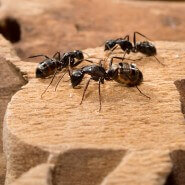Carpenter Ant Frass
Carpenter ants excavate tunnels in wet or decaying wood to establish or expand their nests. The pests dig out extensive galleries for the colony, which weakens lumber from the inside out. Ant frass is usually the first sign of a problem for property owners.

What Does Ant Frass Look Like?
When the ants dig into damp deck railings or window frames, they create small open slits that lead to the surface. The pests use these holes as chutes to push carpenter ant frass out of the tunnels. This debris looks like wood shavings and forms a cone-shaped pile beneath the infested timber. Ant frass includes different materials, such as:
- Wood fragments
- Insect carcasses or ant body parts
- Soil and gravel particles
- Carpenter ant poop
Termite and carpenter ant frass both have the same color as the affected lumber. It can be tricky to tell the difference between the two. However, termites eat wood. The waste they kick out of their galleries consists solely of oval-shaped fecal pellets that fall below the nest. Finding ant droppings and insect limbs within sawdust-like debris indicates carpenter ants rather than termites.
Signs of a Carpenter Ant Infestation
Both residential and commercial spaces are at risk for carpenter ant problems. Infestations often go unnoticed until after the damage has already occurred. Common indicators include:
- Long trails of the pests on walls, floors, or counters
- Piles of carpenter ant frass
- Multiple oblong openings on wood surfaces
- Timber that sounds hollow when tapped
- Smooth, clean tunnels found inside moist or rotting lumber.
New England’s rainy climate can lead to wood rot in window and door frames, leaving them vulnerable to carpenter ant nests. Leaking pipes or sinks in homes and restaurants, as well as damaged roofing on rental properties or warehouses, add excess moisture to lumber supports, too. Also, tree branches and shrubs that touch the building may bring the pests indoors.
Discovering mounds of ant frass is often the first sign of an infestation. Left unchecked, a large colony can mean serious structural damage to your property. If you see carpenter ant frass around your home or business, call Waltham Pest Services or contact us online to consult with a professional.